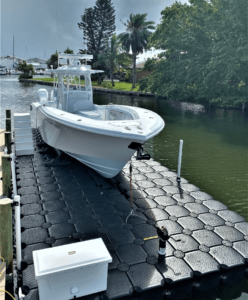Dock Construction Near Me can accommodate many purposes. For example, lakefront homeowners might want a larger dock to hold picnics while they tan or watch boats go by.
The floor conditions of a body of water can greatly affect a dock’s design and construction. These factors include sand, silt, rock, clay, and vegetation.

Dock pilings are the foundation of a dock, and they must be strong enough to support the weight of boats and people. They must also resist the damage of underwater pests such as marine borers and roosting birds. The right piling type will depend on your water conditions and the load capacity you need.
Wood, concrete, and steel are common materials for pilings. Each has different benefits and disadvantages depending on the environment, including water salinity, water depth, and weather conditions. Wood pilings are relatively inexpensive, easy to install, and rot-resistant. They are also environmentally friendly since they don’t contribute to deforestation. However, they are susceptible to damage from the sun’s UV rays and from storm surge and tidal pressure. They may need to be replaced periodically.
Concrete pilings are a popular choice for commercial and industrial applications because they are strong, durable, and long-lasting. They can support much heavier loads than wood or PVC pilings, and they’re also resistant to corrosion and insect infestation. However, they’re often expensive to construct and aren’t aesthetically pleasing.
Stainless steel pilings are an excellent option for harsh environments because they are corrosion-resistant and can withstand tidal pressures. They’re also easy to install and can support heavy loads. Stainless steel is more expensive than other piling types, but it’s worth the investment for its longevity and durability.
In addition to their structural integrity, pilings help stabilize the structure of the dock and protect it from erosion. They anchor the dock to the seabed and prevent it from shifting as the tide rises and falls. They also help to prevent the eroding of shorelines and make it safer for people and boats to enter and exit the water.
Pile drivers and dock builders use specialized tools to drill and drive pilings into the ground or water surface. They also perform inspections and repairs to waterfront structures. They are trained to understand the unique environmental conditions of each area and choose the right dock material and design for their clients’ needs. They can also provide guidance to clients on how to maintain and repair their structures.
Unlike piling docks, suspension docks are designed to hang above the water with cables and ropes that anchor them. These are a more recent design that has gained popularity around waterfront areas. Their main advantage is that they are able to adjust their height in response to rising and falling water levels. However, they are also more expensive than other types of docks.
Choosing a dock that is right for your property can be a complicated task. You need to consider personal needs and the environment, as well as cost and local laws. The first thing you need to think about is the type of shoreline you have. Every type of shoreline has a unique ecosystem that impacts the environment and marine life that lives there.
If you have a rocky shoreline, you will find that it is full of rocks, pebbles and boulders. This type of shoreline is common along oceans, lakes and some riverfronts. This rocky shoreline is home to a specific type of marine ecosystem known as an intertidal zone. It is important to avoid disrupting this ecosystem during construction of a dock, as even minor disturbances can have adverse chain reactions.
In addition to their ecological significance, rocky shorelines are prone to erosion. While some erosion is natural, you should try to minimize it by using the right materials during your dock installation. Avoid using concrete and steel to construct a dock, as these can cause damage and contaminate the surrounding ecosystem. Instead, choose wood to build a dock that is more durable and easier to maintain.
A sandy shoreline is a much more diverse and fragile environment. It is home to many different animals, plants and insects that help to balance the ecology and aid in global climate conditions. If you are considering a dock on a sandy shoreline, it is important to consult with your environmental office and building officials before constructing one. They may be able to advise you on the best ways to protect the environment while still allowing you to build your dock.
Floating docks can be constructed from various materials, including aluminum, steel, and plastic. The latter is the most environmentally friendly, as it does not contain chemicals that are harmful to marine life. It is also more affordable than other dock designs, and it is easy to clean and repair if damaged. Among the top plastic dock manufacturers is Hisedock, which has clients in over 45 countries.
When deciding whether to go with a floating dock or a fixed one, it’s important to consider the body of water you will be installing it in. This will help you determine what type of features and accessories you may want to add. For example, extra safety railings are a good idea for docks that sit on the ocean or other salty bodies of water where corrosion can be an issue. Other accessories, like kayak and canoe launches, swimming platforms and slides, and personal watercraft ports are popular choices in recreational settings, like summer camps and waterside resorts.
Floating docks are designed to rise and fall with the ebb and flow of the tide. This is an ideal choice for tidal waters, but they also work well for non-tidal bodies of water. Since they are less invasive than fixed docks with piles or legs, these types of installations tend to be less disruptive to the surrounding environment as well.
These types of installations require a minimum of two inches (plastic) to four inches (aluminum) of water depth to maintain their stability. They are able to withstand waves of up to one foot, though they are not meant for use in areas with frequent through traffic by boats whose wakes could cause damage to the dock.
They are available in a variety of colors, sizes and shapes to suit your waterfront aesthetic. Depending on the company you choose to work with, they may also offer modular floating dock sections and configurations that can be customized and expanded to fit your specific needs.
These are typically made with wood or aluminum framing and a deck that rests on the surface of the water. They can be constructed with a ramp that adjusts to rising and falling tides, or a gangway that connects the dock to the shoreline. These types of installations are a good option for lakes and rivers because they do not have the same environmental concerns as oceans and other salty bodies of water, and they are relatively less invasive than fixed installations with legs or pilings that can damage sediment.
The type of dock you choose depends on what your specific needs are for your waterfront property. For example, if your waterfront is on the ocean, you want a dock that can withstand salty conditions and abrasions from waves, wind and currents. In this case, you need to consider a structural dock, which has a solid foundation anchored in the bottom by wooden or metal pilings. This type of dock is a good option for permanent, year-round use and provides stability without movement in the water.
Alternatively, if your property is on a river or other tidal waterway, a floating dock is a better choice. Floating docks are easy to remove and reposition, making them great for seasonal uses. They also cause less damage to the sediment and don’t require many (if any) permits. They are also more resistant to movement in the water due to storms and tidal surges, but they may be less stable if you’re expecting frequent large changes in water level.
When choosing a dock, it’s important to determine what your budget is and what kind of maintenance you’re willing to undertake. If you have limited funds, a basic floating dock can still provide all the benefits of a traditional dock, just on a smaller scale. It will also be easier to maintain, since the construction materials are less likely to rust or decay over time.
A pier is another useful marine construction used for mooring or berthing large sea-going vessels and container ships. They are also used for loading and unloading cargo. A dry dock is a similar structure, but it can be drained to allow for examining, repairing or building ships.
In some cases, a permit is required to build a dock. If your dock or pier is located in a tidal regulated area, you’ll need to apply for a permit. If your site is in a flood hazard zone, the permit will need to address both the dock construction and the riparian zone disturbance.
The construction of a new dock requires a significant investment of money and labor. Before you start the process, be sure to thoroughly investigate your options and discuss any potential problems with the local zoning authorities or conservation agency.
